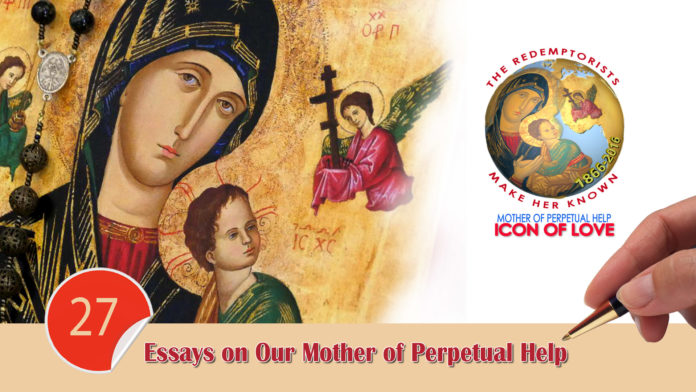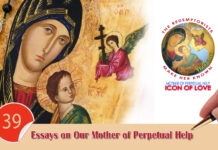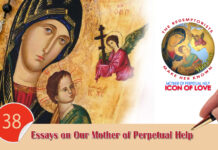“It is true, most loving Mother that I do not deserve to be your child, because my sinful life had made me unworthy. I will be quite content if you accept me merely as your servant. Just to be numbered among your lowliest servants. I would give up all the treasures of the world. Yes, I would be satisfied with this if only I could continue to call you, ‘Mother.’”
St. Alphonsus de Liguori
The Glories of Mary
According to religious tradition, Mary was a Jewish woman of Nazareth in Galilee in the first century. She is the vessel of salvation and the conduit of the incarnation. Mary found favor with God. She was chosen by God and through the Holy Spirit, gave birth to the Savior of the world. This teenage Nazarene girl because of her availability to God for the work of salvation history would become not only “blessed among women,” but also known throughout time by various names and titles. They include Blessed Virgin Mary, Mother of God, Saint Mary in Western churches and Theotokos in Orthodox Christianity and Maryam in Islam. Mary, the daughter of Joachim and Ann, the wife of Joseph the carpenter and the mother of Jesus, the Christ, would also have significance in the myriad artistic depictions throughout history. Every nationality and ethnic culture has identified and sought to venerate the mother of Jesus in paintings, iconography and sculptures that had meaning for their specific culture. I dare say, that while the icon of Our Mother of Perpetual Help is unquestionably Byzantine by design, it’s cultural origins transcends any particular culture or religious tradition and has trans-cultural significance and meaning.
How does one define an icon? In the Orthodox Church, an icon is a sacred image, a window into heaven. An image of another reality, or a person, time and place that is more real than here and now. More than art, icons have an important spiritual role. In his book, The Icon: Window on the Kingdom, the author, Michael Quenot says that an icon is “theology in imagery, the icon expresses through color what the Gospel proclaims in words.” [1] The primary purpose of an icon is to lead us to prayer and worship. While icons are not created to force an emotional response, it is amazing how an icon draws one in, seemingly the image in the icon is looking at you and does in fact invoke a response that is both emotional as well as cerebral. In viewing an icon there is no dichotomy between feeling and thinking, the head and the heart. An icon depicts silence. There are no actions displayed, no mouths open. An icon invites the Christian to enter into contemplation, prayer, discernment and silence: to listen. In the midst of reflective silence, icons gently compels one to ponder deeply its mystery and meaning. While most icons have a clear objective rationale, I contend that like many artistic expressions, icons can “speak” to people in ways that are personal and subjective as well.
It is my intention to explore the various significant aspects of the ancient icon of Our Mother of Perpetual Help and its implications in growing in the spiritual life and the ministry of evangelization. As a Redemptorist, my reflection will most definitely be informed and influenced by our charism, history, traditions and devotions; however, as an African-American Redemptorist my spiritual and theological understanding are certainly undergirded by the cultural gifts as a descendant of the African Diaspora. Thus, with this cultural position, I will highlight the unique ways that the icon “speaks” to us as Mary our help in time of trouble; Mary as channel of hope and Mary as model of discipleship.
Mary: Our Help In Time of Trouble
Undoubtedly the most popular image of our Blessed Mother is under the title of “Our Mother of Perpetual Help.” The Redemptorists have succeeded in fulfilling the admonition of Pope Pius IX “to make her known throughout the world.” Devotion to Our Mother of Perpetual Help occurs throughout the world in many and varied languages and cultures. The icon transcends culture because the image of Mary and Jesus and the messages it conveys universally reach the very core of the human condition. The Christ Child has the appearance of apprehension when presented with instruments of His passion. In His mother, He finds the greatest comfort and tenderness. In His haste to run into her protective arms, He almost loses one of his sandals thereby signifying to us that we should hasten to seek her loving assistance in our troubles. Christ’s fingers hold his Mother’s right hand, yet they rest quite loosely there. In this lies another lesson. Through the protection of His holy Mother, Jesus grew to His adulthood and initiated His redemptive work. As she protects Him, she also intercedes for our protection and wellbeing.
It is commonly understood that a mother is one who nurtures, comforts and protects. These are basic maternal instincts. A mother neither neglects nor forsakes her child. A child has the assurances of love and safety when his or her mother is near. In the icon of Our Mother of Perpetual Help, one sees and senses that motherly protection. Mary’s image looms large over a small yet adult-looking Jesus. The image conveys that from infancy to adult maturity, I will also be there to protect my child. The Mother of Perpetual Help icon says to us “that as I protected my child, so I will protect you.” The idea of “perpetual help” is appealing. It calls us to abandon the need to be defensive, to cease being anxious, to lay down the heavy burdens that we have been carrying and simply to trust. In the icon the instruments of Jesus’ passion frightened him and caused him to run quickly to his mother. It causes us to consider the issues and circumstances that causes us fear and brings upon trouble in our lives. In life, there are very few things that are infinite; therefore, having a sense of there being a “perpetual help” reminds us that God and by extension, God’s chosen vessel, our Blessed Mother is an ever-present help in our times of trouble.
Being reared in an African-American traditional Catholic household, the image of Our Mother of Perpetual Help was prominently displayed in our home. Mary’s icon in our home brought to my family a sense of God’s abiding presence and protection. Within the context of African-American spirituality, there is a confidence of knowing that “God is able” to bring us through our problems, that God can truly heal, help and deliver us from devastating circumstances, and that God would never abandon us in our times of trouble and misfortune. There is a well-known African-American religious idiom that “trouble don’t last always!” My mother would encourage my brothers and me to seek the intercession of Our Mother of Perpetual Help in whatever problems that we were dealing with. Knowing that this divine motherly protection was always with us seemed to make difficult moments in life much more bearable.
Our Redemptorist constitutions and statutes reminds us that “among groups of people more in need of spiritual help, they will give special attention to the poor, the deprived and the oppressed.” (Constitution #4) My own vocation was merited by witnessing Redemptorist missionaries working as parish priests and Brothers in a poor urban neighborhood seeking to bring help and healing to those who were unjustly treated and socially, politically and economically deprived and oppressed. Their witness and fidelity to the poor was so strong that they never explicitly spoke of their charism but in fact lived it. I witnessed their great preaching and promotion of devotion to Our Mother of Perpetual Help and I somehow knew that Mary was undoubtedly a source of their dedication to helping the poor. It was clear that this Madonna who was one who “helps”, inspired these Redemptorist missionaries to help others. I believe that if as Redemptorists we seek to evangelize the poor and to be evangelized by the poor, we have to seek the motherly encouragement of Our Mother of Perpetual Help to teach us how to be present to the poor, especially when it seems an inconvenience and allow them to run to us in their times of fear and apprehension to find solace, security, peace and comfort. The poor will only come running to us as Redemptorists, if we but first leave our comfort and security and run to them and learn from them what it means to be unsafe, vulnerable and helpless. For the poor and oppressed, sense of spirituality and holiness is essentially derived from experience. God is not the God of speculation and neither is the Blessed Mother! Both God and Mary act in life. For the poor, all that is holy, specifically Mary the ever-attentive Mother of Jesus, teaches, guides, protects, and remains faithful even when humanity is not faithful. The icon of Our Mother of Perpetual Help instructs us as Redemptorists how to be fully committed to our vocation to preach good news to the poor and most abandoned by having first experienced and thus are enabled to show unconditional love and unfailing help.
Mary, Channel of Hope
It has been said, “Never deprive someone of hope—it may be all they have.” While some may interpret that statement as a dramatic generalization, I contend that the ability to hope in the face of overwhelming odds indeed enables one to overcome life’s struggles. When someone says, “I have hope,” what are they actually saying? Are they saying I know that my situation is so dire that I have hope regardless of the facts suggesting the contrary? Is hope merely wishful or fantastical thinking in order to trick one’s self into believing things will turn out all right? It is important to note here that hope is not the prospects or hypotheses of futurology. Hope is not the conviction that in human conflicts on whatever levels, the good always triumphs over the bad, the poor over the powerful, and the truth over falsehood. Sometimes yes, sometimes no.
What, then, is hope? Christian hope is the security to obtain, possess, and enjoy “what we cannot see.” If we saw it, with the senses, or with human logic, or with scientific or natural projections, then we would no longer hope. Given this theory, can one assume that there are real distinguishing factors between hope and faith? What distinguishes hope from faith? According to Chilean Father Segundo Galilea in his book Spirituality of Hope,[2] “hope is the firm conviction that the promises we know by faith will be fulfilled. Not the whole content of faith is proper to hope, only contents of the promises of faith.” From a theological perspective, hope is what we receive, the promises that we gain by possessing faith. Our faith is rooted in what we know and believe about God.
Without question, the icon of Our Mother of Perpetual Help teaches us that Mary is present to help us but the icon also vividly displays a message of hope. The virtue of hope has been described as “having something to hold on to.” In this sense, the icon depicts Jesus gently but assuredly holding on to his mother’s hand. Literally Jesus’ hand is in Mary’s hand. As Redemptorists at the center of our vocation is to convey to the most abandoned poor a message of hope. We are called to minister in places that no one wants to go, places in need of urgent pastoral care. Those places are places were many have little or no hope. Meditation on the sacred image of Jesus holding his mother’s hand instills in us the hope that our Constitution and Statutes call us to – as men who are: “strong in faith, rejoicing in hope, burning with charity, on fire with zeal, in humility of heart and preserving in prayer.” (Const # 20) The very hope and assurance that Mary gives to the Redeemer, is the same hope that the sons of St. Alphonsus must bring to those to whom we minister.
In Mary, we find a woman of hope. She is the model of hope in the most disconcerting of circumstances. She received Jesus into her life with no guarantees of certainty; she trusted and believed that God’s word of promise would be fulfilled. With a promise from God, she told the angel Gabriel, may it be done to me according to your word.” (Luke 1:38) Mary possessed hope at the annunciation of Jesus; hope during the crucifixion of Jesus; hope in the resurrection of Jesus and hope in the ascension of Jesus. Mary lived a hopeful life and calls us to do the same. Pope Francis, on reflecting on the Blessed Mother said, “Hope is what Mary, Mother of God, sheltered in her heart during the darkest time of her life: Friday afternoon until Sunday Morning. That is hope: she had it. And that hope has renewed everything. May God grant us that grace.”[3]
Mary, Model Of Discipleship
One of the most distinctive aspects of the icon of Our Mother of Perpetual Help is the fact that she does not look at her frightened Child but looks at us. Why does she look directly at us? Mary’s eyes draw all who look into her face toward the mystery of redemption that she holds in her arms. Her look is one of great compassion but also one of intensity. It is a piercing glance. This artistic style in Marian iconography explicitly showing Mary holding the Child Jesus but directly looking at us signifies that Jesus blesses the one whom His mother gazes upon. Mary’s gaze toward us not only blesses us but also invites us to be disciples and evangelists of Jesus Christ as she herself was. She accompanied Jesus from His conception in her womb until His death on the cross. In doing so, she followed Jesus in a perfect manner. The purpose the Congregation of the Most Holy Redeemer is “to follow the example of Jesus Christ, the Redeemer…” Mary shows us, and all Christians how to follow Jesus. Mary is the model of discipleship.
Luke presents Mary as the one who hears the word of God. It is evident in the first two chapters of his Gospel. Luke pictures Mary as a model of discipleship in his Gospel. In Luke 11:27-28, he emphasizes this idea one more time. “While he was speaking, a woman from the crowd called out and said to him, “Blessed is the womb that carried you and the breasts at which you nursed.” He replied, “Rather, blessed are those who hear the word of God and observe it.” (Luke 11:27-28). The woman praises Mary for being the mother of Jesus. But Jesus points out that genuine blessing comes from the hearing the word and keeping it. Here Jesus does not deny Mary’s status as his mother. On the other hand, Jesus praises his mother for hearing the word of God and doing it. Mary is blessed not only because she gave birth to Jesus and nursed him in his infancy but also because she is hearer and doer of the word. God delights in her and accomplished great things because of her faith. Like the woman in the crowd, we see a similar blessing in Luke 1:42. Elizabeth praises Mary for her faith and her conception of Jesus. “Most blessed are you among women, and blessed is the fruit of your womb”. Mary is blessed because she is the mother of Jesus. She became mother of Jesus since she was obedient to the word of God. Therefore, according to the criteria of Jesus, Mary is also included in the group of those who are blessed.[4] Of all the Evangelists, Luke gives the fullest and most empathetic picture of Mary. He does not hesitate to point out Mary’s intimate thoughts. He expresses Mary’s dilemma at the angel’s greeting, her joy at the visitation to the Elizabeth, and her anxiety during her searching for Jesus when he was twelve years old. Luke pictures Mary as a simple woman who is a model of obedience, humility, discipleship and sublime faith.[5]
Our Mother of Perpetual Help is a mother at every moment to help us. She encourages us to trust in God in times of trouble, to hold on to hope in moments of discontent and discouragement and to remain steadfast in following her son, Jesus as faithful disciples. As Redemptorists, we must look to our patroness, Our Mother of Perpetual Help, to help us live fully our anointed vocations to preach good news to the poor and most abandoned. Through her motherly compassion and intercession, may she assist us in being true apostles with and for the poor, to break the chains that hinder them and us from experiencing the Gospel as good news. May we grow in our love for Jesus as His mother loved Him. And by her example may we become ever-fervent evangelizers always drawing those most in need of Jesus to Jesus.
Mother of Perpetual Help, pray for us!
Maurice J. Nutt, C.Ss.R., Province of Denver
———–
[1] Michael Quenot, The Icon: Window on the Kingdom. (Yonkers, NY: St. Vladimir’s Seminary Press, 1992), 28.
[2] Segundo Galilea, Spirituality of Hope (Maryknoll: Orbis Books, 1998), 4.
[3] Pope Francis, Homily at Mass at Casa Santa Marta, October 29, 2013.
[4] Raymond E. Brown; ed., Mary in the New Testament, 172.
[5] Lucien Deiss, Mary: Daughter of Sion, (Collegeville, MN: Liturgical Press, 1972), 129.






